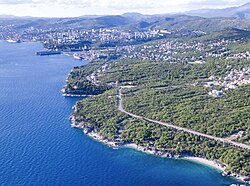
Opatija is a town and a municipality in Primorje-Gorski Kotar County in northwestern Croatia. The traditional seaside resort on the Kvarner Gulf is known for its Mediterranean climate and its historic buildings reminiscent of the Austrian Riviera.

Rijeka, also known as Fiume, is the principal seaport and the third-largest city in Croatia. It is located in Primorje-Gorski Kotar County on Kvarner Bay, an inlet of the Adriatic Sea and in 2021 had a population of 108,622 inhabitants. Historically, because of its strategic position and its excellent deep-water port, the city was fiercely contested, especially between the Holy Roman Empire, Italy and Croatia, changing rulers and demographics many times over centuries. According to the 2011 census data, the majority of its citizens are Croats, along with small numbers of Serbs, Bosniaks and Italians.

Primorje – Gorski Kotar County is a county in western Croatia, most of it based in the historical and cultural region called Croatia proper and some of it in Istria, including the Bay of Kvarner, the surrounding Northern Croatian Littoral, and the mountainous region of Gorski Kotar. Its center is Rijeka. The county's population was 296,195 at the 2011 census.

Hrvatski nogometni klub Rijeka, commonly referred to as HNK Rijeka, is a Croatian professional association football club from the city of Rijeka.

Krk is a Croatian island in the northern Adriatic Sea, located near Rijeka in the Bay of Kvarner and part of Primorje-Gorski Kotar county. Krk is tied with Cres as the largest Adriatic island, depending on the methodology used to measure the coastline. Krk is the most populous island in the Adriatic, with multiple towns and villages that contain a total of 19,916 (2021) inhabitants.

Crikvenica is a town in Croatia, located on the Adriatic in the Primorje-Gorski Kotar County.

Omišalj is a coastal municipality in the north-west of the island of Krk in Croatia. The population of Omišalj itself is 1,887 (2021), while the municipality also includes the nearby village of Njivice, bringing the total population to 2,992. Omišalj is best known in modern times for hosting the Rijeka Airport as well as Port of Rijeka oil terminal.
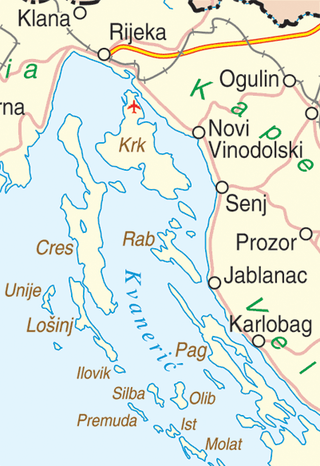
The Kvarner Gulf, sometimes also Kvarner Bay, is a bay in the northern Adriatic Sea, located between the Istrian peninsula and the northern Croatian Littoral mainland. The bay is a part of Croatia's internal waters.

Lovran is a village and a municipality in Primorje-Gorski Kotar County, Croatia. It is situated in eastern Istria, on the western coast of the Kvarner Bay. Its name derives from Laurel, as shown in the coat of arms.

Baška is a village and a municipality located on the southeast of the island of Krk, in Primorje-Gorski Kotar County, Croatia. According to the 2011 census, the municipality has a population of 1,656, with 899 in Baška itself.

Gorski Kotar is the mountainous region in Croatia between Karlovac and Rijeka. Because 63% of its surface is forested it is popularly called the green lungs of Croatia or Croatian Switzerland. The European route E65, which connects Budapest and Zagreb with the Adriatic Port of Rijeka, passes through the region.

Trsat is part of the city of Rijeka, Croatia, with a historic castle or fortress in a strategic location and several historic churches, in one of which the Croatian noble Prince Vuk Krsto Frankopan is buried. Trsat is a steep hill, 138 m high, rising over the gorge of the Rječina river, about a kilometre away from the sea; strategically significant from the earliest times right up to the 17th century, it is today a major Christian pilgrimage centre and home to a statue of Pope John Paul II who came to Trsat as a Pilgrim in 2003. Today, the University of Rijeka's newly constructed campus lies in the western part of Trsat.
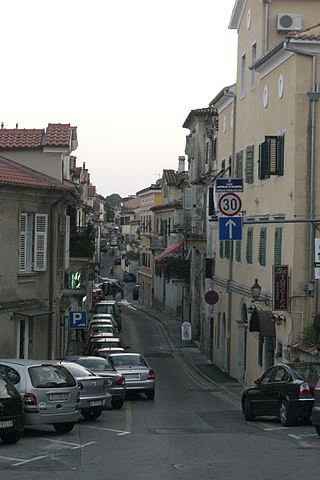
Volosko is a part of the city of Opatija, located in the Kvarner Gulf in western Croatia. It is located in the north of Opatija, on the road towards Kastav and Rijeka. The toponym Volosko drives from the name of the Slavic deity Veles.

Croatian Littoral is a historical name for the region of Croatia comprising mostly the coastal areas between traditional Dalmatia to the south, Mountainous Croatia to the north, Istria and the Kvarner Gulf of the Adriatic Sea to the west. The term "Croatian Littoral" developed in the 18th and 19th centuries, reflecting the complex development of Croatia in historical and geographical terms.
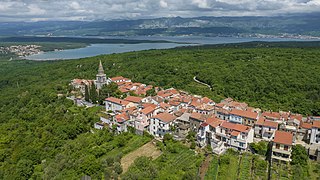
Dobrinj is a village and municipality in the Primorje-Gorski Kotar County in northwestern Croatia, on the island of Krk. There are 2,150 inhabitants in the municipality, with 91% Croats. The village of Dobrinj itself has 89 inhabitants.
INA-Industrija nafte, d.d. is a Croatian multinational oil company. INA Group has leading role in Croatia's oil business, a strong regional position in the oil and gas exploration and production, oil processing, and oil product distribution activities. INA, d.d. is a stock company with the Hungarian MOL Group and the Croatian Government as its biggest shareholders, while a minority of shares is owned by private and institutional investors. INA shares have been listed at the London and Zagreb stock exchanges since December 1, 2006. INA Group is composed of several affiliated companies wholly or partially owned by INA, d.d.. The Group has its headquarters in Zagreb.
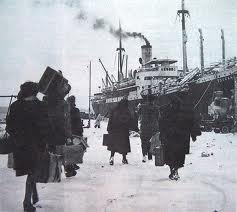
The Italian language is an official minority language in Croatia, with many schools and public announcements published in both languages. Croatia's proximity and cultural connections to Italy have led to a relatively large presence of Italians in Croatia.

Ika is a small village in Croatia.It is a suburb of Opatija settled in Kvarner bay area under the Učka Mountain. It is connected by the D66 state road with Rijeka and Pula. As a part of Opatija it has been developed from fisherman‘s village to tourist destination with access to Lungomare beaches and proximity of Nature park Učka. In Ika there are 2 beaches separated by an old pier. In this small place you can find restaurants and hotels located at the beachfront.
The Port of Rijeka is a seaport in Rijeka, Croatia, located on the shore of the Kvarner Gulf in the Adriatic Sea. The first records of the port date to 1281. It was the main port of the Kingdom of Hungary in the 19th century and the beginning of the 20th century, of Yugoslavia between World War II and 1991, and of Croatia after its independence. Today, it is the largest port in Croatia with a cargo throughput of 13.6 million tonnes (2020), mostly oil, general cargo and bulk cargo, and 344,091 Twenty-foot equivalent units (TEUs).

Italians of Croatia are an autochthonous historical national minority recognized by the Constitution of Croatia. As such, they elect a special representative to the Croatian Parliament. There is the Italian Union of Croatia and Slovenia, which is a Croatian-Slovenian joint organization with its main site in Rijeka, Croatia and its secondary site in Koper, Slovenia.
